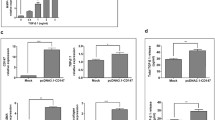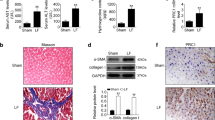Abstract
Background and Purpose
Liver fibrosis is characterized by accumulation of extracellular matrix. Our previous study found that osteopontin (OPN) increased in plasma of cirrhotic patients and indicative of cirrhosis staging. The present study was designed to investigate the expression of OPN in liver tissues and plasma of cirrhotic patients and further explore the role of OPN in human hepatic stellate cell (HSC) activation.
Methods
We used immunohistochemical staining and enzyme-linked immunosorbent assay to evaluate the expression level of OPN in liver tissues and plasma from cirrhotic patients, respectively. We produced lentivirus particles and infected target cell to manipulate OPN expression. Infection efficiency was determined by real-time RT-PCR and western blot. Cell proliferation was determined using CCK8 assay, and phenotypes of HSC activation were determined by real-time RT-PCR. OPN promoter activity was determined by dual luciferase reporter assay.
Results
We found that OPN expression in human cirrhotic liver tissues was upregulated compared to normal controls. In addition, its expression correlated with Child-Pugh classification, MELD score and the occurrence of complications. We further explored OPN level in patients’ plasma and showed that its level correlated with transforming growth factor-β1 (TGF-β1). In human HSC cell line LX-2, we found that change of OPN expression level could not only affect the proliferation of cells but also the TGF-β1 mediated HSC activation. Moreover, OPN was increased by TGF-β1 stimulation and regulated by TGF-β1 at transcription level.
Conclusions
OPN is upregulated in liver tissues and plasma of cirrhotic patients and promotes TGF-β1 mediated HSC activation.




Similar content being viewed by others
References
Bataller R, Brenner DA. Liver fibrosis. J Clin Invest. 2005;115:209–218.
Moreira RK. Hepatic stellate cells and liver fibrosis. Arch Pathol Lab Med. 2007;131:1728–1734.
Carpino G, Franchitto A, Morini S, et al. Activated hepatic stellate cells in liver cirrhosis. A morphologic and morphometrical study. Ital J Anat Embryol. 2004;109:225–238.
Kawada N. Human hepatic stellate cells are resistant to apoptosis: implications for human fibrogenic liver disease. Gut. 2006;55:1073–1074.
Lee UE, Friedman SL. Mechanisms of hepatic fibrogenesis. Best Pract Res Clin Gastroenterol. 2011;25:195–206.
Gressner AM, Weiskirchen R. Modern pathogenetic concepts of liver fibrosis suggest stellate cells and TGF-beta as major players and therapeutic targets. J Cell Mol Med. 2006;10:76–99.
Ueberham E, Low R, Ueberham U, et al. Conditional tetracycline-regulated expression of TGF-beta1 in liver of transgenic mice leads to reversible intermediary fibrosis. Hepatology. 2003;37:1067–1078.
Cheng K, Yang N, Mahato RI. TGF-beta1 gene silencing for treating liver fibrosis. Mol Pharm. 2009;6:772–779.
Lee JH, Lee H, Joung YK, et al. The use of low molecular weight heparin-pluronic nanogels to impede liver fibrosis by inhibition the TGF-beta/Smad signaling pathway. Biomaterials. 2011;32:1438–1445.
Du SS, Qiang M, Zeng ZC, et al. Radiation-induced liver fibrosis is mitigated by gene therapy inhibiting transforming growth factor-beta signaling in the rat. Int J Radiat Oncol Biol Phys. 2010;78:1513–1523.
Breitkopf K, Godoy P, Ciuclan L, Singer MV, Dooley S. TGF-beta/Smad signaling in the injured liver. Z Gastroenterol. 2006;44:57–66.
Nagao M, Feinstein TN, Ezura Y, et al. Sympathetic control of bone mass regulated by osteopontin. Proc Natl Acad Sci USA. 2011;108:17767–17772.
Schordan S, Schordan E, Endlich K, Endlich N. AlphaV-integrins mediate the mechanoprotective action of osteopontin in podocytes. Am J Physiol Renal Physiol. 2011;300:F119–F132.
Maki M, Hirota S, Kaneko Y, Morohoshi T. Expression of osteopontin messenger RNA by macrophages in ovarian serous papillary cystadenocarcinoma: a possible association with calcification of psammoma bodies. Pathol Int. 2000;50:531–535.
Apparao KB, Murray MJ, Fritz MA, et al. Osteopontin and its receptor alphavbeta(3) integrin are coexpressed in the human endometrium during the menstrual cycle but regulated differentially. J Clin Endocrinol Metab. 2001;86:4991–5000.
Giachelli CM, Steitz S. Osteopontin: a versatile regulator of inflammation and biomineralization. Matrix Biol. 2000;19:615–622.
Mazzali M, Kipari T, Ophascharoensuk V, et al. Osteopontin—a molecule for all seasons. QJM. 2002;95:3–13.
O’Regan A. The role of osteopontin in lung disease. Cytokine Growth Factor Rev. 2003;14:479–488.
Johnson GA, Burghardt RC, Bazer FW, Spencer TE. Osteopontin: roles in implantation and placentation. Biol Reprod. 2003;69:1458–1471.
Philip S, Bulbule A, Kundu GC. Osteopontin stimulates tumor growth and activation of promatrix metalloproteinase-2 through nuclear factor-kappa B-mediated induction of membrane type 1 matrix metalloproteinase in murine melanoma cells. J Biol Chem. 2001;276:44926–44935.
Denhardt DT, Noda M, O’Regan AW, Pavlin D, Berman JS. Osteopontin as a means to cope with environmental insults: regulation of inflammation, tissue remodeling, and cell survival. J Clin Invest. 2001;107:1055–1061.
Lee SH, Seo GS, Park YN, Yoo TM, Sohn DH. Effects and regulation of osteopontin in rat hepatic stellate cells. Biochem Pharmacol. 2004;68:2367–2378.
Syn WK, Choi SS, Liaskou E, et al. Osteopontin is induced by hedgehog pathway activation and promotes fibrosis progression in nonalcoholic steatohepatitis. Hepatology. 2011;53:106–115.
Urtasun R, Lopategi A, George J, et al. Osteopontin, an oxidant stress-sensitive cytokine, up-regulates collagen-i via integrin alpha(V) beta(3) engagement and PI3K–pAkt–NFkappaB signaling. Hepatology. 2012;55:594–608.
Zhao L, Li T, Wang Y, et al. Elevated plasma osteopontin level is predictive of cirrhosis in patients with hepatitis B infection. Int J Clin Pract. 2008;62:1056–1062.
Delimpoura V, Bakakos P, Tseliou E, et al. Increased levels of osteopontin in sputum supernatant in severe refractory asthma. Thorax. 2010;65:782–786.
Zhao L, Jiang S, Hantash BM. Transforming growth factor beta1 induces osteogenic differentiation of murine bone marrow stromal cells. Tiss Eng Part A. 2010;16:725–733.
Wang WH, Jiang CL, Yan W, et al. FOXP3 expression and clinical characteristics of hepatocellular carcinoma. World J Gastroenterol. 2010;16:5502–5509.
Xu L, Hui AY, Albanis E, et al. Human hepatic stellate cell lines, LX-1 and LX-2: new tools for analysis of hepatic fibrosis. Gut. 2005;54:142–151.
Li YL, Wu J, Wei D, et al. Newcastle disease virus represses the activation of human hepatic stellate cells and reverses the development of hepatic fibrosis in mice. Liver Int. 2009;29:593–602.
Paradis V, Dargere D, Bonvoust F, et al. Effects and regulation of connective tissue growth factor on hepatic stellate cells. Lab Invest. 2002;82:767–774.
Thampanitchawong P, Piratvisuth T. Liver biopsy: complications and risk factors. World J Gastroenterol. 1999;5:301–304.
Regev A, Berho M, Jeffers LJ, et al. Sampling error and intraobserver variation in liver biopsy in patients with chronic HCV infection. Am J Gastroenterol. 2002;97:2614–2618.
Ahmad W, Ijaz B, Gull S, et al. A brief review on molecular, genetic and imaging techniques for HCV fibrosis evaluation. Virol J. 2011;8:53.
Denzer UW, Luth S. Non-invasive diagnosis and monitoring of liver fibrosis and cirrhosis. Best Pract Res Clin Gastroenterol. 2009;23:453–460.
Cao S, Yaqoob U, Das A, et al. Neuropilin-1 promotes cirrhosis of the rodent and human liver by enhancing PDGF/TGF-beta signaling in hepatic stellate cells. J Clin Invest. 2010;120:2379–2394.
Wynn TA. Cellular and molecular mechanisms of fibrosis. J Pathol. 2008;214:199–210.
Kamath PS, Kim WR. The model for end-stage liver disease (MELD). Hepatology. 2007;45:797–805.
Huang W, Zhu G, Huang M, et al. Plasma osteopontin concentration correlates with the severity of hepatic fibrosis and inflammation in HCV-infected subjects. Clin Chim Acta. 2010;411:675–678.
El-Din BS, Elwan NM, Suliman GA, El-Shourbagy SH. Clinical significance of plasma osteopontin level in Egyptian patients with hepatitis C virus-related hepatocellular carcinoma. Arch Med Res. 2010;41:541–547.
Stevenson M, Lloyd-Jones M, Morgan M, Wong R. Non-invasive diagnostic assessment tools for the detection of liver fibrosis in patients with suspected alcohol-related liver disease: a systematic review and economic evaluation. Health Technol Assess. 2012;16:1–174.
Hunter C, Bond J, Kuo PC, Selim MA, Levinson H. The role of osteopontin and osteopontin aptamer (OPN-R3) in fibroblast activity. J Surg Res. 2011.
Schaefer B, Rivas-Estilla AM, Meraz-Cruz N, et al. Reciprocal modulation of matrix metalloproteinase-13 and type I collagen genes in rat hepatic stellate cells. Am J Pathol. 2003;162:1771–1780.
Kisseleva T, Brenner DA. Role of hepatic stellate cells in fibrogenesis and the reversal of fibrosis. J Gastroenterol Hepatol. 2007;22:S73–S78.
Borkham-Kamphorst E, Herrmann J, Stoll D, et al. Dominant-negative soluble PDGF-beta receptor inhibits hepatic stellate cell activation and attenuates liver fibrosis. Lab Invest. 2004;84:766–777.
Di Sario A, Bendia E, Svegliati BG, et al. Effect of pirfenidone on rat hepatic stellate cell proliferation and collagen production. J Hepatol. 2002;37:584–591.
Acknowledgments
This work was supported by National Natural Sciences Foundation of China, No. 81070350. We thank Technician Zheng Chen in our lab and Dr. Jiuxu Bai from Shenyang General Hospital of PLA for technical assistance. We thank Professor Gaoliang Ouyang (School of Life Sciences, **amen University) for providing the OPN plasmid. We also thank Prof. Scott L. Friedman (Mount Sinai School of Medicine, USA) for providing LX-2 cells.
Conflict of interest
The authors declare no conflicts of interest related to this work.
Author information
Authors and Affiliations
Corresponding authors
Additional information
**ao **ao and Yi Gang contributed equally to this work.
Electronic supplementary material
Below is the link to the electronic supplementary material.
10620_2012_2248_MOESM1_ESM.tif
Fig. S1 Comparison of OPN and TIMP1 expression levels in consecutive sections of cirrhotic liver tissues. Representative images of coordinate expression of OPN and TIMP1 (kappa = 0.518, P = 0.000) were showed (original magnification, 200×). (A, B) Positive OPN staining (A) and positive TIMP1 staining (B) were observed in consecutive sections of cirrhotic liver tissues. (C, D) Negative OPN staining (C) and negative TIMP1 staining (D) were observed in consecutive sections of cirrhotic liver tissues. Supplementary material 1 (TIFF 10,280 kb)
Rights and permissions
About this article
Cite this article
**ao, X., Gang, Y., Gu, Y. et al. Osteopontin Contributes to TGF-β1 Mediated Hepatic Stellate Cell Activation. Dig Dis Sci 57, 2883–2891 (2012). https://doi.org/10.1007/s10620-012-2248-7
Received:
Accepted:
Published:
Issue Date:
DOI: https://doi.org/10.1007/s10620-012-2248-7




